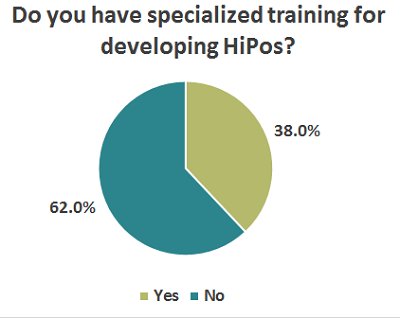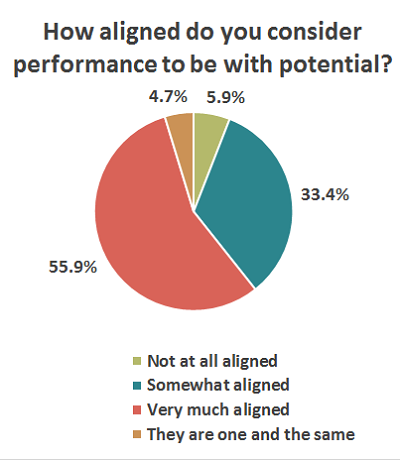In Yesterday’s Advisor we explored some of the results of our 2015 High Potential Employee (HiPo) survey. Today we’ll continue and explore the rest of those results.
Talent Management

55.3% of respondents make use of succession planning, and 51.1% use talent pipelines as talent management strategies. 39% of survey takers said that they make use of talent pools, and 34.4% make use of talent inventories as part of their talent management strategies. The majority of “other” responses (8.5%) answered that they don’t use any talent management strategies.
Succession Planning

When asked how important succession planning is to our survey takers, the overwhelming majority (90.5%) found it to be at least “important” (24%), “very important” (42.5%), or “extremely important” (24%). Only 7.8% said it is “somewhat important” and a mere 1.8% said it is “not at all important.”
Succession planning may be important to nearly all of the survey takers, but 46% of respondents say they manage succession planning by dealing with vacancies as they arise—in other words, they don’t actually have a plan. 30.3% said, “We have a plan for critical roles within our organization.” Only 7.1% said, “We have a contingency for every potential vacancy,” and the same percentage (7.1%) said they have a complete map of several specific individuals who can take over any vacancy at any time. 7.1% answered “Other,” and some of those “Other” responses include:
- “Turnover is low—(1%) so current focus is more on prep for retirement.”
- “Company doesn’t have a system yet, we are building it.”
- “We are in the development stage of planning.”
- “While we have plans for many critical positions, we do not have plans for all such positions.”
Performance Reviews and Succession Planning

Most respondents said that they use performance reviews as a general model for how HiPos would work in any particular vacancy (38.1%), or that they don’t connect performance reviews to their succession plans (28.6%). 22.6% said that they explicitly use performance reviews as a measure of employee potential while planning succession. Only 5% of respondents said that they use performance reviews to settle disagreements as to who should fill a particular vacancy. Only 5.7% of respondents answered “other.”
HiPos are the future of your company. Learn what your competitors may be up to with our new research report, HiPos and Succession Planning: Securing Your Company’s Future. Learn More
Training HiPos

When asked “Do you have specialized training for developing HiPos?” only 38% of the respondents said that they do, while the majority (62%) said that they don’t. We also asked them to specify what kind of specialized training they provide. The number one response was “in-house mentorship” at 59.6%. The next three were all very similar, with 50.4% saying that they use “company-operated leadership training,” 48.9% saying they use “outside or consultant coaching/leadership training,” and 48.9% saying they use “additional skills or jobs training.” 13.5% answered “other,” and here are some of those responses:
- “I’m not given authority to address this.”
- “HR has begun using development plans monthly.”
- “Opportunities for classes for certification in specific disciplines.”
- “A training program lead by existing executives and managers to prepare them for the next step.”
The Relationship Between Performance and Potential

It’s clear that participants find performance and potential to be similar or connected. When participants were asked what they perceived to be the relationship between performance and potential, the majority (55.9%) said that they considered it to be “very much aligned.” 33.4% said it is “somewhat aligned.” The more extreme answers both got low responses, with “not at all aligned” selected by 5.9% of respondents, and “they are one and the same” selected by 4.7%.
Participants
A total of 406 individuals participated in this survey, which was conducted in September, 2015. At 40.9%, managers made up the largest portion of the respondent pool. A little less than one-third of participants (29.2%) identified as executives (i.e., VP level or higher), and staff-level employees made up 7.6% of those surveyed. The smallest group represented (at 6.3%) was comprised of supervisors.
Of those who identified themselves, the majority (61.7%) represent privately owned, for-profit companies; 17.9% are employed by nonprofits; 9.4% work in the public sector; and government organizations were represented by 11.0% of the response pool.
Our respondents represented a large variety of industries, with the largest four industries being health care and social assistance (11.4%); manufacturing (16.9%); professional, scientific, technical services (11.4%); and finance and insurance (10.7%).
There was a pretty good spread among the sizes of companies involved with 18.4% of participants from companies with 101–250 employees, 17.1% from those with 1–50 employees, 17.1% from those with 25–500 employees, 15.5% from those with 51–100 employees, and 13.5% from those with 1,001–5000 employees. 9.4% of those responded were from companies with 501–1000 employees, and 9% from those with over 5,000 employees.
Get the rest of the survey results here:
How do HR departments find, develop, and retain HiPos? It’s all in this report: HiPos and Succession Planning: Securing Your Company’s Future. Click Here
Among the features of this new product:
- Full results of our national survey addressing HiPos
- Executive summary and highlights
- And much more!
High potential employees (HiPos) are more than just employees who perform well. They are those unique employees who will, under the right circumstances, help make your organization great going forward. What are real-world organizations doing with HiPos? How do they identify them? What do they do to keep them? Find out what our survey takers had to say.
